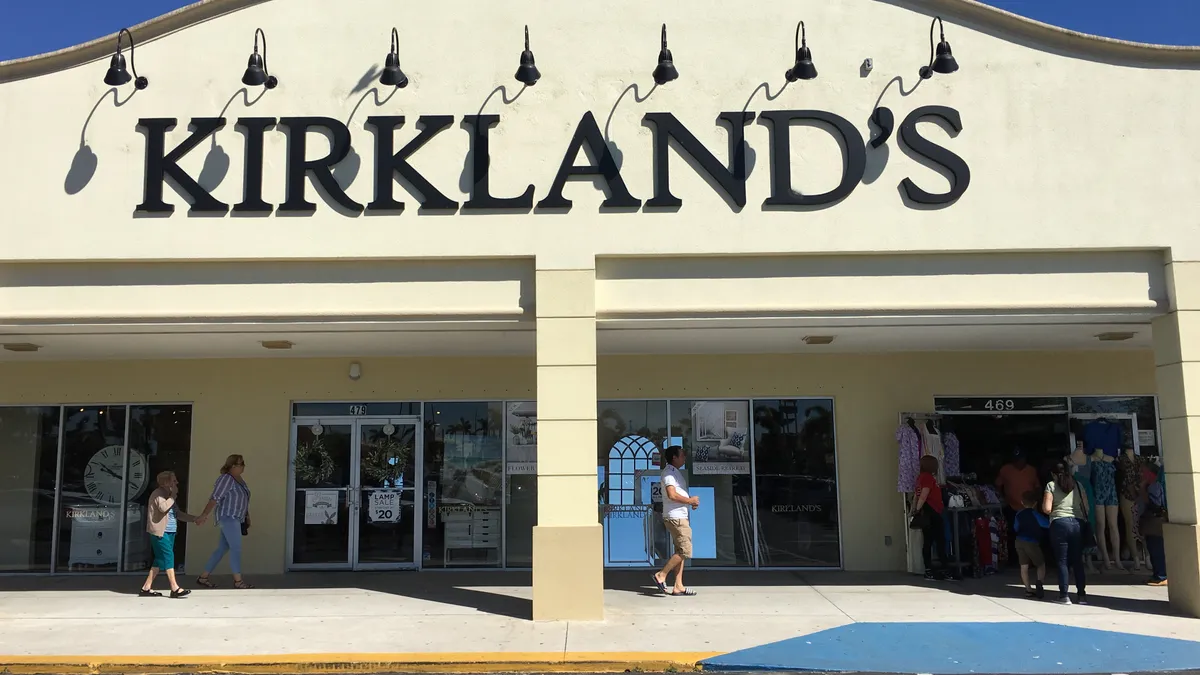Last week, Macy’s announced that it will be closing up to 40 stores in the beginning of next year, a move many observers attribute to the downturn of the American mall.
But rather than blame the decline of American malls for Macy's decreased store traffic, Nick Egelanian, president of retail real estate consulting firm SiteWorks, instead blames the demise of the American mall on Macy's and its full-line department store cohorts.
As consumer shopping habits evolved over the past 30 years, Egelanian told Retail Dive that many department stores have been slow to adapt in a rapidly changing retail environment spurred by the advent of e-commerce.
Among other factors, this slowness to adapt is contributing to the decline of American malls—and, at a macro level, the upheaval of retail itself. As Macy’s works to rebound from multiple quarters of slumping sales, its plans to revive its business will be a good barometer of whether the American department store can survive and adapt to the digital age .
Macy's caught in shift from department stores to big-box retail
While department stores were many Americans' go-to shopping destinations for much of the 20th century, there have been signs for many years that these shopping institutions, including Macy's, are in decline.
“If you look at full-line department stores—Sears, J.C Penney, Macy’s—15 years from now that business will be 50% of the size it is today,” Egelanian said. “This process started over 30 years ago.”
The shift began when big-box stores expanded shoppers’ choices when they were looking to buy everyday household items, according to Egelanian. While customers may have traveled to department stores for most of their shopping 30 years ago, now they are heading to Target or Wal-Mart.
“It’s interesting that most of what department stores sold when they where in their heyday of their business is now sold in big box stores, not in department stores,” said Egelanian. “The consumer has been moving away from department stores for decades.”
While Macy’s business may still seem healthy right now—Macy’s is still number one in apparel retail, although research firm Cowen and Company has predicted that Amazon will leapfrog Macy’s to take the top spot in a couple of years—the Internet and off-price stores have siphoned shoppers away from Macy’s, where over 50% of its profits are now attributed to women’s apparel and accessories.
“Americans have learned to buy many of their basic needs in off-price or big box rather than regional malls,” Egelanian said.
Rather than being seen as a go-to place for every need, department stores have now turned to outside partnerships to help attract shoppers and expand their customer base. Macy’s recently announced a partnership with Best Buy, which will put Best Buy concessions in 10 of its stores, staffed by the electronic retailer’s employees.
The retailer has also acquired beauty and spa retailer Bluemercury, tapping into a thriving area of retail that attracts many price points. While fellow department store J.C. Penney has been inundated with financial worries of late, its partnership with Sephora has been a bright spot, with the segment’s same-store sales growth doubling in the most recent quarter.
"Beauty is a core signature business for Macy’s and Bloomingdale’s and a continued platform for our company’s profitable sales growth,” Macy's CEO Terry Lundren said in a statement after the acquisition. "With Bluemercury, our company can access a new channel to reach additional customers, add new dimensions to our product offering and apply our expertise in omnichannel retailing.”
But one analyst says that Macy’s has some work to do when it comes to other partnerships, arguing that they lack the panache of Nordstrom’s pop-up stores, which have included partnerships with hot brands like Warby Parker, Bauble Bar, and Top Shop.
Macy’s “brand partnerships are weak,” Mark Cohen, director of retail studies at Columbia Business School, told Retail Dive. “They are more focused on celebrity than something of consequence. Nordstrom’s collaborations give it a differentiating strategy.”
When asked about its ability to differentiate, Macy's spokesman Jim Sluzewski said the company's web offerings help it bring many options to their customers. "There is strong competition up and down the spectrum but we think Macy’s has a critical place in the middle and a broad lane that serves the whole middle spectrum of American shoppers," said Sluzewski.
Betting on off-price retail
While analysts highlight its partnerships and pop-up shops, Nordstrom's success as a department store goes beyond those strategies. Macy's doesn't position itself as a competitor of Nordstrom, but the upscale department store's moves are ones that Macy's may want to replicate in its own way.
Both Egelanian and Cohen noted that Nordstrom was smart for anticipating the success of off-price stores like TJX’s T.J. Maxx and Marshalls. Nordstrom not only opened its first Nordstrom Rack off-price store back in 1975, but the retailer has also scaled back its mall-based department stores and invested heavily in expanding the number of Nordstrom Rack locations in the years since then.
“The most effective answer to the changing marketplace is what Nordstrom has done,” said Egelanian. “It got to 100 stores, and then realized the basic way apparel shopping is changing.”
Today, the company has 118 full-line Nordstrom stores and 183 Nordstrom Rack stores, with plans to open 27 more Nordstrom Rack stores this year, announced in the company’s 2014 annual report.
Macy’s is also investing in this off price concept, opening its first Bloomingdale's the Outlet Store in 2009—something that Jim Sluzewski, a Macy’s spokesman, was quick to point out to Retail Dive. But the number of these stores pales in comparison to Nordstrom’s Racks, largely because Macy's started its off-price development so much later than Nordstrom. Macy's currently has 14 of these outlet stores versus 37 full-line Bloomingdales department stores.
This month, Macy’s unleashed its latest answer to the off-price trend—new off-price Macy’s Backstage stores. The goal for Backstage, like Macy's partnership with Best Buy, is to attract an even broader consumer base and capture their loyalty, with the ultimate goal of transitioning these customers to its full-price department stores. Backstage won’t compete with Bloomingdale’s outlets, tailoring its merchandise and shopping experience instead to target shoppers leaving its stores for TJX’s Marshalls and T.J. Maxx, which have seen steady rise in both stores and profits in recent quarters.
"What we learned from research is that the customer today shops across the board. The same customer that shops at Wal-Mart will shop at Neiman Marcus for different kinds of things," said Sluzewski. "Backstage will enhance the brand, introducing Macy's to a new customer, and bring back Macy's customers who may be going to competition for other products."
While Macy’s is less interested in the upscale bargain hunter with its Backstage stores—perhaps helping it avoid competing with Nordstrom Rack—the market it is stepping into is already quite crowded.
T.J. Maxx and Marshalls – just two brands in TJX’s overall company – had 2,094 stores in the U.S. and Puerto Rico at the beginning of this year, with plans to grow to 3,000 T.J. Maxx and Marshalls stores in the country.
Others have raised concerns that Macy’s Backstage concept will dilute its brand, conditioning its shoppers to expect deals both at the off-price stores and its full-line department stores.
“I think the outlet strategy is inappropriate for Macy’s,” said Cohen. “I think they're going to further cannibalize their core business, and in fact they are responding almost knee jerk-like to the success of Nordstrom’s Rack, and the poke in the eye [that] TJX is to them.”
Can Macy's find its way in the new retail landscape?
Though some onlookers have said that its new initiatives fall in the “too little, too late” category, Macy's said its recent performance is not necessarily indicative of its long-term success.
“We had a couple of soft quarters and I don’t think that means that there’s a huge falloff of where we are as a company,” said Sluzewski.
While this may be a common refrain for all businesses when they encounter down quarters, this sentiment was echoed by some analysts, as the shedding of underperforming stores is seen as a necessary way to trim unwanted fat and place a greater focus on its e-commerce and omnichannel initiatives.
“While making the decision to close stores is difficult, we know it is necessary for us to remain competitive as customer shopping patterns continue to change,” Macy's CEO said in a statement.
Particularly important is Macy’s focus on seamless shopping from online to in-store and its omnichannel fulfillment process—two things that Sluzewski said is critical to serving Macy's customer base. Every one of Macy’s 770 stores currently serve as mini-fulfillment centers to help Macy’s quickly deliver online orders and cut down on shipping costs. Sluzewski called Macy’s online business a “leader” in the industry when it comes to creating fluid interactions between online and in-store shopping.
The department store is investing in its digital future, recruiting top tech talent in Silicon Valley and expanding its same-day delivery to more markets in a bid to compete with Amazon. According to Lundgren, the company is on pace this year to jump from the number seven spot in Internet Retailer’s list of top e-commerce retailers to number five next year.
"I wouldn't call one or two quarters of weak consumer demand in general the end of Macy's," Matt McGinley, an analyst at ISI Equity Research, said in an interview with CBS Money Watch. "They are still a gigantic retailer. They are the biggest department store operator. They are still generating $28 billion in revenues. It's not going away anytime soon."
While Macy’s planned growth initiatives should help it evolve in an era of rapidly changing consumer tastes, it is yet to be seen whether the retailer will fully recover and resume growing, especially as competition rapidly expands and its home base—the shopping mall—continues to decline. Macy's e-commerce investments hold promise, but its brick-and-mortar stores may need to innovate their approach. But if Macy's can capture the modern shopper with its new partnerships and Backstage stores—while ridding itself of its discounting habits in its department stores—it may be ready to recapture its glory days of years past.





















